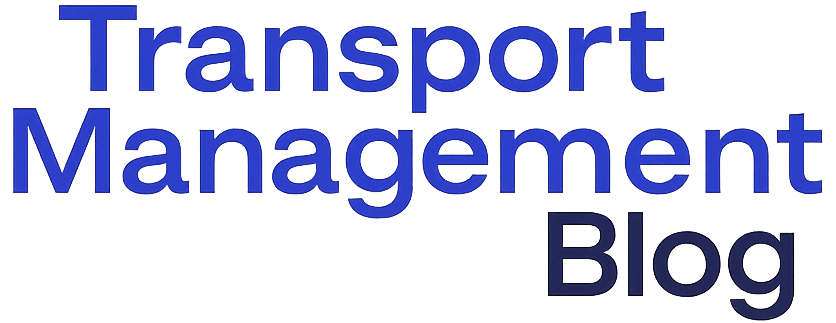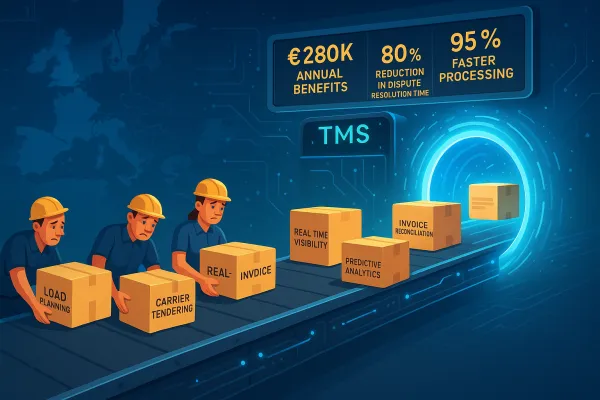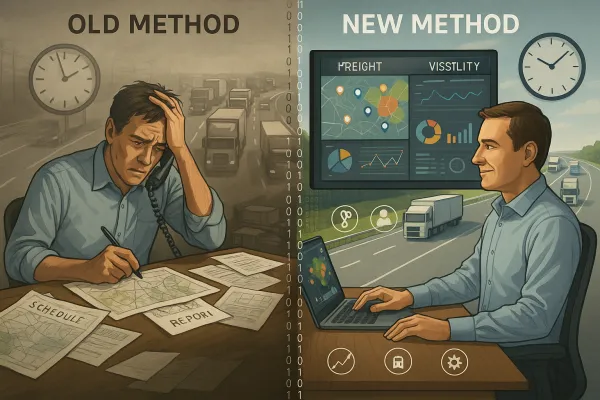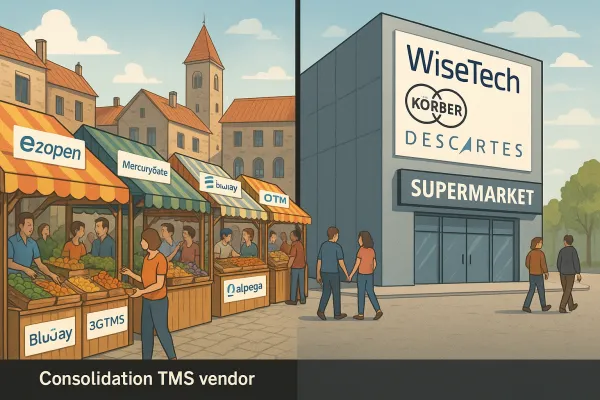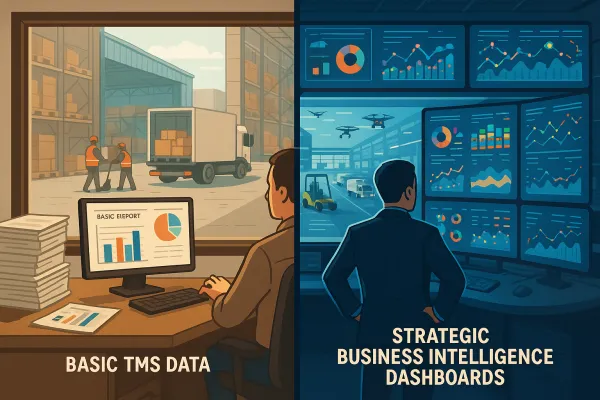API vs EDI for European TMS Integration: The Complete Decision Guide for Scalable Carrier Connectivity
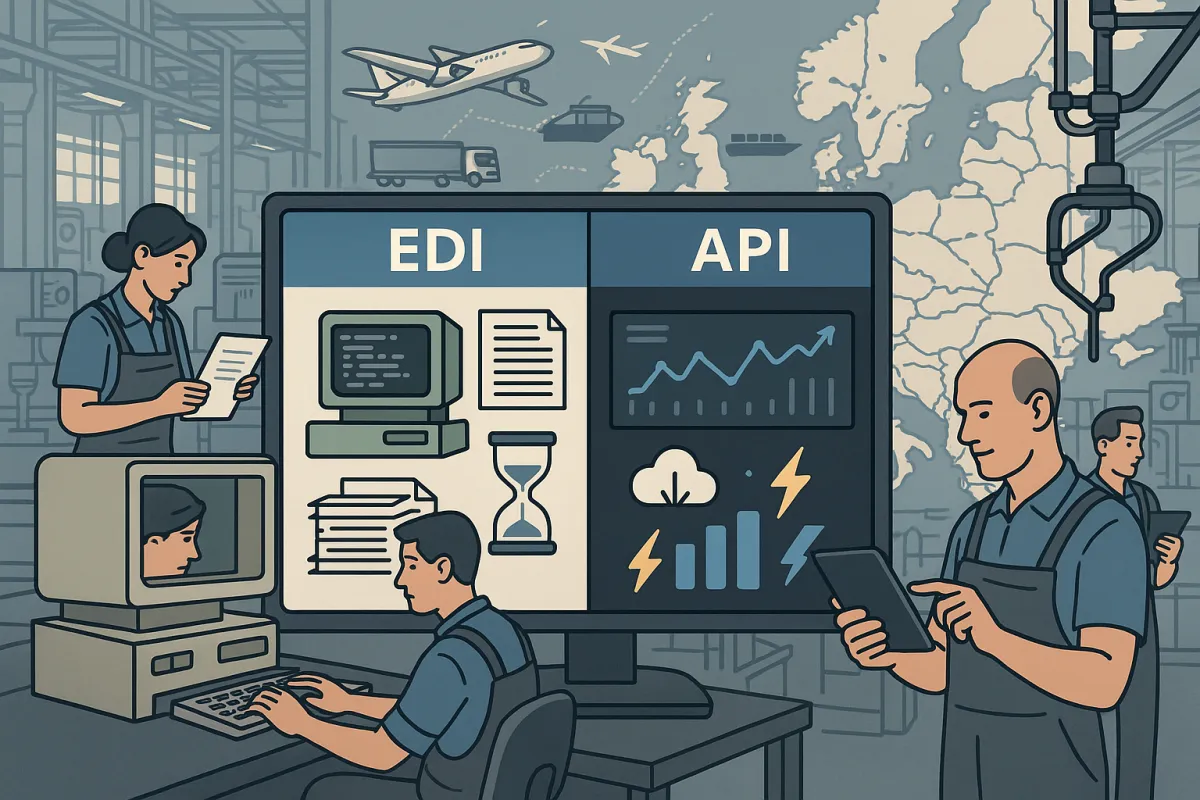
The integration maze facing European manufacturers and wholesalers with €10M+ transport spends has reached a breaking point. USA Truck discovered their EDI tools couldn't scale when they expanded their carrier network from 200 to 500+ partners. Processing times increased from 2 minutes to 45 minutes for standard load tenders. This isn't an isolated issue. Research by Ovum shows that 53% of enterprises experience limitations with their current B2B integration solutions when onboarding trading partners, with approximately 40% requiring over 30 days to bring a new partner online.
With the European TMS market reaching around € 1.4 billion in 2024 and growing at a compound annual growth rate (CAGR) of 12.2 percent, forecasted to reach € 2.5 billion in 2029, the stakes for making the right integration choice have never been higher. European shippers need clarity on whether to double down on EDI, embrace APIs, or navigate a hybrid approach when implementing their TMS API integration strategy.
Understanding Your Integration Options: API vs EDI Fundamentals
The core difference comes down to timing and architecture. With cloud-based solutions, API allows transportation management systems (TMS) to transmit data in less than a second. Meanwhile, EDI, having been standardized around the 1970s, works by establishing a secure and reliable peer-to-peer connection to transmit data from physical documents. This technology can send a large volume of information at once, and it typically aids SQL integration with legacy systems.
EDI integrations may take several months, whereas, API integrations can take a matter of weeks, if not days, and files may have complex formats requiring the labor of specialists. Here's the practical impact: when you need to onboard a new carrier urgently, APIs give you that flexibility. When you're managing stable, high-volume relationships with established partners, EDI's reliability becomes an asset.
Why Legacy EDI Still Dominates (And Its Growing Limitations)
EDI continues its explosive growth trajectory, with B2B electronic sales rising from $7 trillion in 2019 to $8.38 trillion by 2021, accounting for 76.5% of all digital commerce and growing year-over-year by 8.3%. The numbers tell a compelling story about trust and established processes.
European manufacturers particularly value EDI for compliance-heavy operations. Despite EDI's age, it is still effectively used today by many large retailers or huge organizations for tasks within transportation such as sending load tenders, status updates, and invoices. Major German automotive suppliers, for example, rely on EDIFACT standards for their complex multi-tier supply chain communications.
But the limitations are becoming harder to ignore. ERP, TMS, and WMS tend to have very lightweight EDI processing. Companies may need different communication software to support various protocols, scripts to complete EDI processing, scripts for database table lookups, or integration between different databases. An order may go to the core ERP, stock transfers to the WMS, and shipping information to the TMS. If EDI is bundled inside core ERP, businesses may not seamlessly process EDI for WMS or TMS transactions like 940s, 204s, or 214s because ERPs may lack applicable fields or modules.
The API Advantage: Real-Time Data and Modern Flexibility
APIs transmit data in milliseconds. This allows a transportation management system (TMS) to run on real-time data, whether you're getting tracking updates, building loads or getting spot quotes. For European shippers managing just-in-time operations or responding to supply chain disruptions, this speed difference becomes critical.
APIs are flexible and customizable, offering exchangeable, real-time information that work with various software, applications and platforms. This means complete transparency and maximum efficiency. API implementation can be less costly than EDI because it doesn't require ongoing maintenance or translation services and is an excellent method to differentiate as a partner and service provider.
Consider a practical example: when Tesla chose APIs over EDI for their carrier onboarding, many carriers found themselves in a bind. Kleinschmidt stepped up to the plate, creating a repeatable process for their customers to transform carriers' existing data into API-compatible formats, making onboarding quick and painless.
The European Carrier Landscape: Integration Realities by Transport Mode
European transport integration isn't uniform across modes or regions. Germany's FORTRAS system serves as EDI backbone for many domestic transport operations, while EDIFACT remains the standard for cross-border European freight. Major carriers like Dachser, DB Schenker, and Kuehne + Nagel have invested heavily in both EDI infrastructure and newer API offerings.
From 2026, all the countries in the European Union will be accepting the e-CMR. Right now in Europe, almost every country has ratified e-CMR, and the remaining countries are expected to ratify by 2026. This regulatory push toward digital documentation is forcing carriers to upgrade their integration capabilities.
The reality check? While many trucking companies are adopting APIs when and where they can, EDI is still widely used in the transportation industry, and that's not likely to change anytime soon. This creates a mixed environment where your TMS must handle both integration types effectively.
Platforms like Cargoson, alongside solutions from Transporeon, nShift, and others, have responded by offering dual-mode capabilities. This approach acknowledges that European shippers don't have the luxury of choosing just one integration standard.
Making the Right Integration Choice: Decision Framework for European Shippers
Your integration strategy shouldn't be an either/or decision. Plenty of shippers use both EDI and API. The simple approach is just to split workloads. Live, decision-driving data travels via API while audit-critical records that make more sense in a document anyway stay on EDI.
The key decision factors break down differently based on your operational profile:
For High-Volume, Established Operations: When EDI Makes Sense
Choose EDI when you're managing stable, high-volume lanes with established carrier relationships. Although EDI is an 'older' process of exchanging data, a big part of the reason it's still around is very simple: EDI is cost-effective and it works reliably. German automotive manufacturers processing thousands of daily shipments with the same Tier 1 carriers exemplify this use case.
Specifically, at Zipline Logistics, we recently transferred a client from manual order entry to EDI tendering, and we reduced the average processing time by 66%. For operations where consistency matters more than speed, EDI delivers proven results.
For Growing, Agile Operations: API-First Strategy
With faster integration speeds and real-time capabilities, API solutions are a practical way for shippers of all sizes to improve their supply chain operations. Choose APIs when you need to onboard carriers quickly, respond to market changes rapidly, or integrate with modern SaaS platforms.
Mid-sized European retailers expanding into new markets particularly benefit from API-first approaches. The ability to connect with local carriers across different countries without months of EDI mapping becomes a competitive advantage.
Implementation Best Practices: Avoiding Common Integration Pitfalls
Look for prebuilt TMS document flows and templates for common documents like 204s and 210s to shorten implementation time and improve reliability. Consider how your TMS and EDI tools will work with other core systems—a solution that can simplify ERP/EDI integration will reduce duplication and help you adapt faster as your tech stack evolves.
Start with a pilot approach. Start working with one or two lanes, with a few specific carriers, or with a few specific recipients, and make sure that everybody gets used to the new process. Once you're rolling, it's easier to add multiple lanes into multiple recipients and multiple transport partners.
For carrier onboarding, implement self-service portals where possible. Nearly two-thirds (63%) of IT decision-makers say the EDI onboarding process takes too long because of all the different customized requirements demanded by trading partners. Platforms like Alpega, E2open, and Cargoson offer pre-built connector libraries that can dramatically reduce onboarding time.
For deeper visibility, some add a middleware gateway. This cloud service takes in an API call and quietly converts it to X12 or EDIFACT (and back again) so every partner sees its preferred format. This hybrid approach lets you modernize internally while maintaining compatibility with traditional carrier systems.
Future-Proofing Your Integration Strategy: Preparing for 2025-2027
It's, therefore, unlikely that APIs will fully replace EDI as the standard means for connection in the next several years. The European market reality suggests a continued coexistence rather than a complete migration.
Despite predictions of EDI's demise, EDI is not only here to stay but is set to expand, with the global EDI market projected to value $49.213 billion by 2027. However, this doesn't mean standing still on API development.
As Dan Heinen, CEO of Kleinschmidt, pointed out, "The push is going to continue to be digital, digital, digital." Fleets need to embrace this shift to stay competitive. The companies winning in European transport management are those building bridges between both worlds.
Your 2025 strategy should focus on platforms that handle both integration types seamlessly. Modern transport execution software addresses many of these challenges by providing unified platforms that handle EDI, API, and hybrid communication methods from a single interface. Solutions from providers like Cargoson, MercuryGate, and Descartes are evolving to support this unified approach.
The integration decision ultimately comes down to recognizing that European transport management isn't about choosing sides—it's about building systems flexible enough to work with the carrier ecosystem as it exists today while positioning for the digital transformation ahead. Start with your most critical lanes, establish your hybrid framework, and build from there. Your competitive advantage lies not in picking the perfect integration standard, but in executing both reliably and efficiently.
